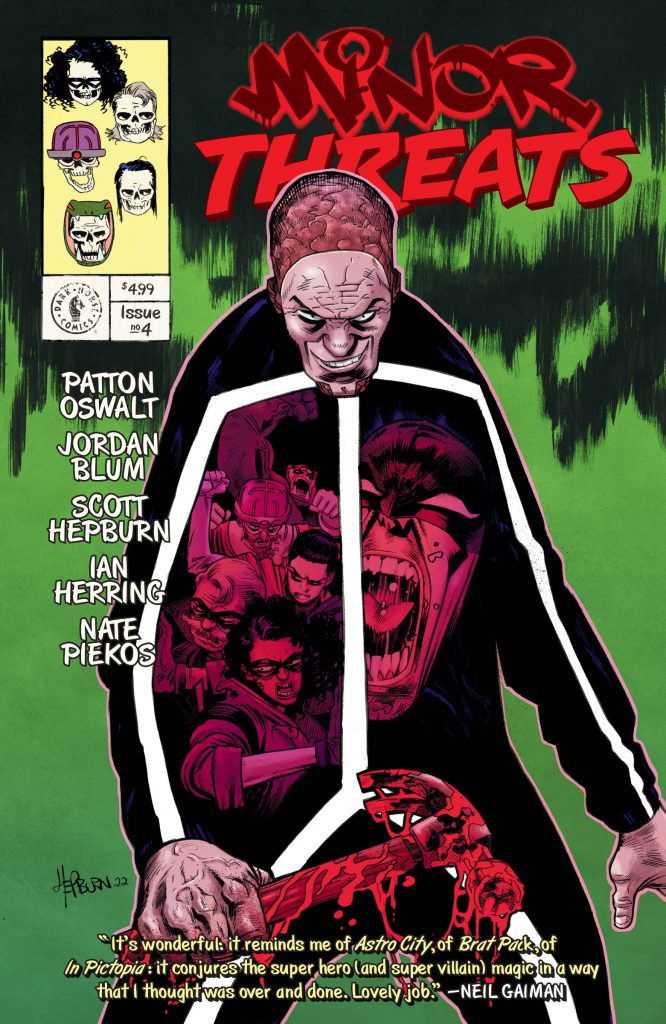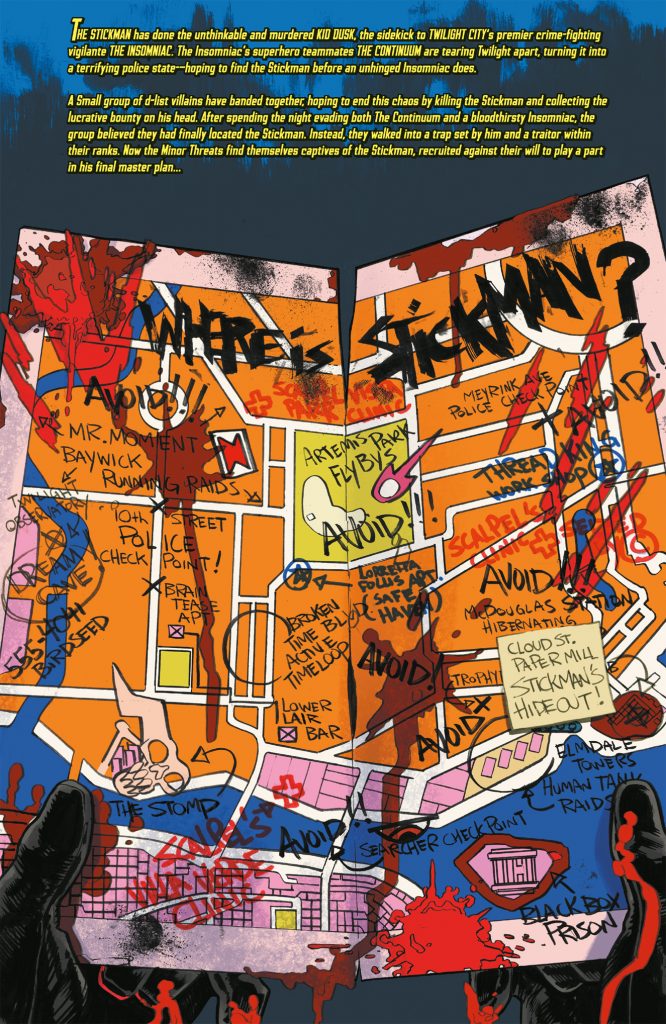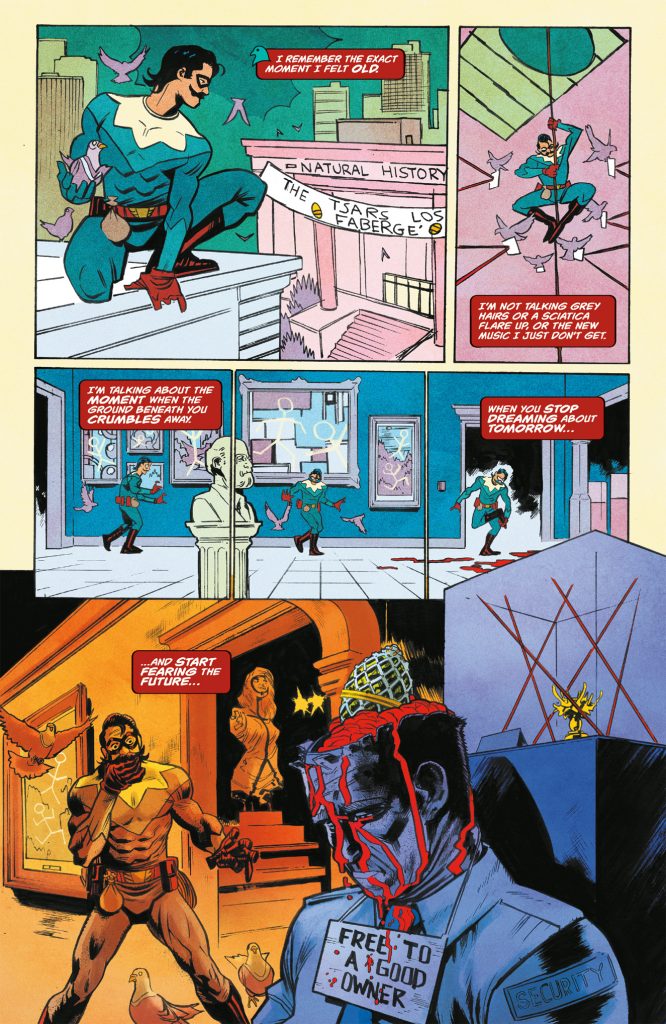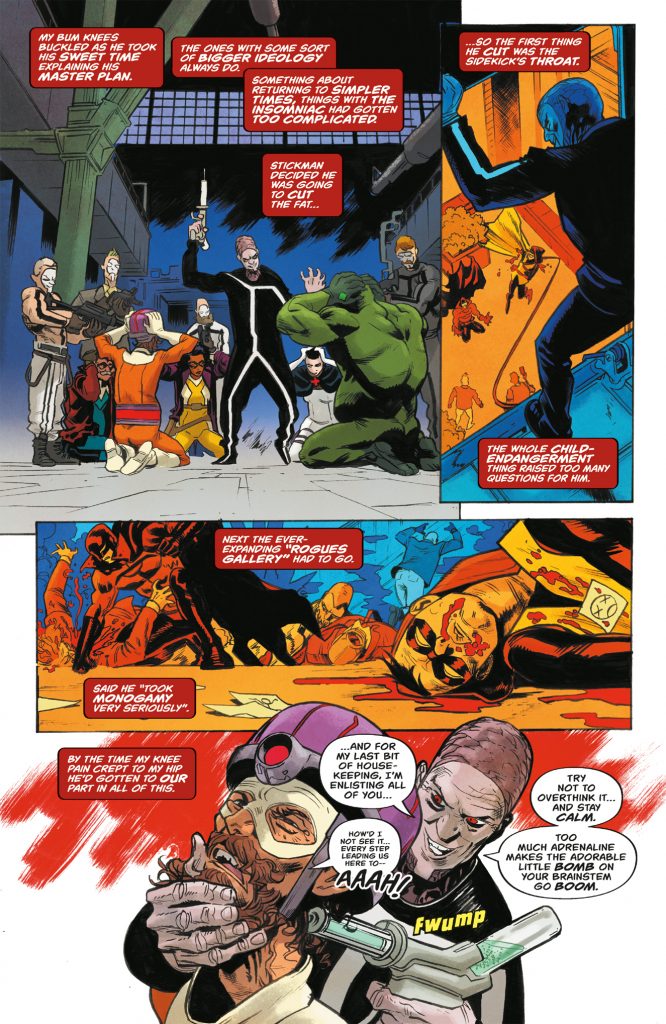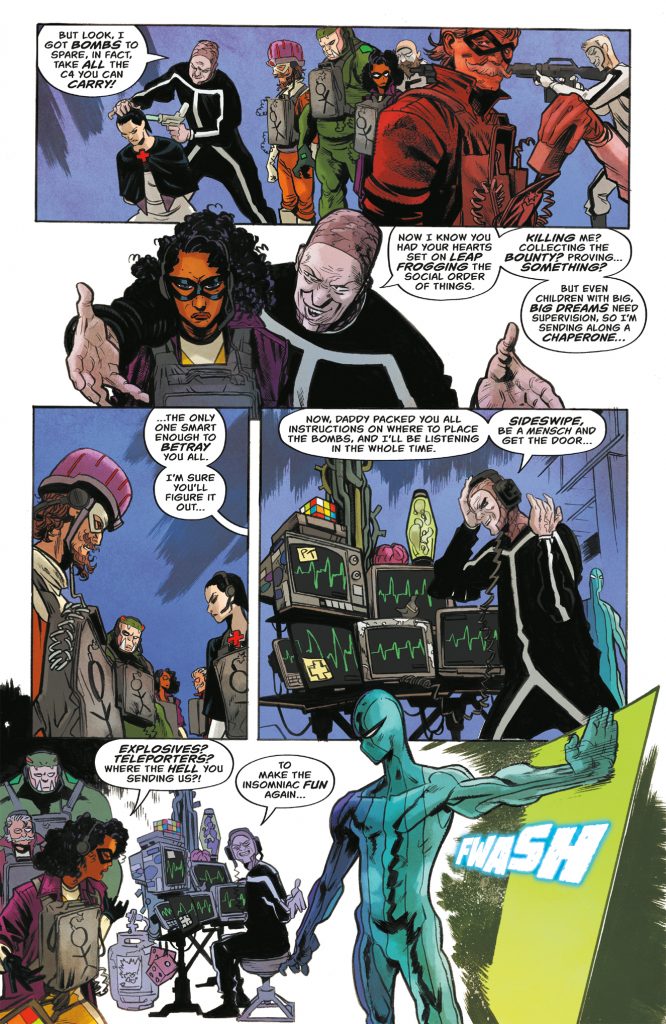This Wednesday, February 1st, 2023, Dark Horse Comics’ Minor Threats #4, written by Patton Oswalt and Jordan Blum, illustrated by Scott Hepburn, colored by Ian Herring, and lettered by Nate Piekos, goes on sale, concluding the tale that kicked off with a group of D-lister supervillains contending with an A-list villain who’s upended their world by murdering one of the heroes of Twilight City, and looks to be ending with a suicide mission in which not everyone will survive. A series populated by characters who are fully realized in both wants and personalities, as well as containing action that has had readers on the edge of their seats, Blum, Oswalt, and all of the talent on the book have created a compelling yarn that will have you rooting for and sympathizing with the bad guy.
Mr. Oswalt and Mr. Blum were kind enough to speak with me about the evolution of Minor Threats, how the Coen Brothers and Batman impacted their tale, why the “off-the-beaten-path” characters appeal to them creatively, and how the book is ultimately about self-improvement and autonomy.
Minor Threats has been a joy to read from beginning to end, with quirky, fleshed-out villains and heroes the likes of which standout among a crowded field of four-color comics. In just four issues, the creative team have done a wealth of character-building and story-crafting that takes some series months to accomplish. While issue #4 is the wrap-up of the series, here’s hoping that we’ll see more of Minor Threats in the near future.
FreakSugar: For folks reading this, what is the conceit of Minor Threats?
Patton Oswalt: Minor Threats is about a group of street-level, D-list costumed supervillains, and their decision to help catch an A-list supervillain who’s upset the balance of law & order in Twilight City. It’s our exploration of the phrase from the 1958 noir The Lineup — “When you live outside the law, you have to eliminate dishonesty.”
Jordan Blum: [The A-list villain] kills the sidekick to the city’s top vigilante, causing hell for all our blue collar criminals.
FS: How did Minor Threats find a home at Dark Horse?
JB: Dark Horse is so good at launching original universes like Hellboy and Black Hammer that it seemed like a good fit.
PO: Dark Horse just seemed like the perfect home for a comic that deals with those sort of ambiguities.
FS: What was the genesis of the series? Was it ignited by any of the other projects on which you collaborated or just from chatting back and forth with an “a ha!” moment?
PO: It started as a Batman story I was thinking of writing, but when I told Jordan the idea, he added some other concepts that immediately exploded the world it was set in, and I knew we had to build a universe from the ground up.
JB: We each separately had our own stories brewing about C-list villains. We both were obsessed with the jobbers, the guys who throw on a snake costume or pick up a freeze gun just to knock over a jewelry store to make ends meet. You can even see that in the “Bar with No Name” episode from our M.O.D.O.K. show. We also both love crime fiction and wanted to tell the story of the little guys, like a Coen Brothers movie, but set in a superhero universe. So we combined our ideas and characters and out of it came Minor Threats.
FS: The book has such a sprawling cast of characters. What was the impetus of introducing so much of the cast at the offset?
JB: We knew [the former supervillain known as Playtime] Frankie would anchor the book, it’s really her journey, but we wanted to surround her with a crew of tragic costumed criminals. The plan was to introduce them all at once and then trade perspectives, giving each character a chance to narrate an issue and hopefully subvert our expectations of who they are. That’s the fun with playing with archetypes, you want the audience to be like “oh he’s a Riddler type” and then we can build and playoff those first impressions into something completely new and fresh.
PO: One of the main reasons was to make the reader feel the dizziness and vertigo of being in such a suddenly massive world — and to also feel the panic and disorientation the characters feel when their “standard operating procedure” gets upended by an A-list villain actually KILLING an A-list hero.
FS: As for that robust cast, what can you tell us about who we’ll meet in the comic? Are there any characters that are particularly near-and-dear?
JB: Frankie, our former villain sidekick failing to go straight, is clearly the house favorite but I ended up really coming to love Scalpel. She’s our “mob doctor” to the supervillain community. She comes off as an icy snob at first but we had a lot of fun excavating her humanity and finding a much more complex character than we originally intended. Some of my other favorite characters are the ones our artist and co-creator Scott Hepburn comes up with in the background. Shiteater, a humanoid fly in a punk jacket Scott put in the bar became instantly beloved.
PO: I have a soft spot for Pigeon Pete, who is a D-lister among D-listers. Someone who loved “the life” of crime more than its rewards, and thus could never truly leave it behind.
FS: Following up on that, what was the process of creating the cast? Did any of the characters materialize whole cloth?
PO: Well, a lot of them are analogues of the “C-List” I was going to assemble for the Batman book. The Batman story was originally called “J” (as a riff on Fritz Lang’s “M”) and the group of lowlifes would have been The Calculator (who’s Brain Tease in our book), Copperhead (Snake Stalker), Crime Doctor (Scalpel), and Crazyquilt (Playtime). Pigeon Pete just sort of appeared out of thin air.
JB: Brain Tease was always going to be a puzzle-based villain who has succumbed to his neurosis and mental illness. Snake Stalker was the muscle-bound heavy we needed but I think we found some subtle ways to make him feel unique in a world of Rhinos and Armadillos.
FS: What are the influences that have impacted both how you approach Minor Threats and how the story and characters take shape? What has helped build the book’s DNA?
JB: For me, it was the Rogues from Flash. Also Superior Foes of Spider-Man. Movies and TV we talked a lot about were Fargo, Raising Arizona, and Breaking Bad. It was important that the book felt 50/50 superhero and crime fiction.
PO: Obviously Astro City and The Suicide Squad. And also Jeff Lemire’s masterful Black Hammer, which I wrote a one-shot for.
FS: Jordan and Patton, you played in MODOK’s sandbox and the cast of Minor Threats seems to be in that kind of offbeat vein. What is it about the off-the-beaten-track type of characters that makes you gravitate toward them?
JB: Their wants are very human. Usually born out of some relatable tragedy that makes you feel for them. Their goals can range from taking over the world to robbing banks but they do it because they’re somehow broken and they think this will fix them. Also usually it’s their own egos or hang-ups that bring them down. They are their own worst enemies.
PO: Because it’s usually the losers who end up being the most human, you know?
FS: What has the collaboration process been like as the series progresses? Is it different from how you’ve worked together in the past?
JB: We started writing the series during the height of the pandemic so it was over zoom. Now we get to finish it in person which is so much more joyous. We usually give ourselves an hour just to bullshit and recommend movies and comics to each other. It’s an important part of the process — get all the tangents out up front before we work.
PO: We beat out the plots, claim different scenes and pages, write ‘em as best we can and then stitch ‘em together.
FS: The first issue was so engaging and fun; beyond that, however, what would you say the series is about? Is there any deeper meaning you see as being underneath the front-facing narrative?
PO: It’s ultimately about what system of honor you create for yourself and how much you can stomach betraying it and still feeling autonomous.
JB: It’s about a bunch of underachieving people trying to escape their lives for better ones. The bounty on The Stickman’s head is dangerous, but it’s a way out. None of them are happy with their lot in life but their own flaws and inability to change keep them trapped there. This is their chance to rise above.
FS: Is there anything you can tease about what we can expect to see in the series?
JB: In the last issue we hinted that there is a traitor in the mix. When you side with villains you’re guaranteed to be betrayed. Also don’t get too attached to your favorite characters. Once they find The Stickman they won’t all be coming back.
Minor Threats #4 debuts this Wednesday from Dark Horse Comics. Make sure to check out our exclusive preview of the final issue!
From the official issue description:
Betrayed by one of their own and at the mercy of the maniac they set out to kill, the Minor Threats are sent on a suicide mission by the Stickman into the inner sanctum of the Insomniac. See which of our cast of C-list costumed criminals make it out alive (hint: not a lot of them) as the most dangerous night of their lives comes to a nail-biting conclusion!
“Minor Threats is exactly what one would expect from Patton Oswalt–it’s intelligent, funny, and twisted. I’m also worried about him.”-Judd Apatow

